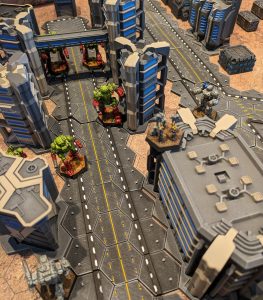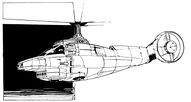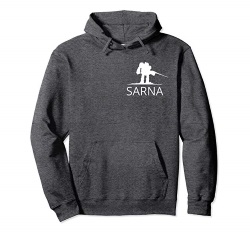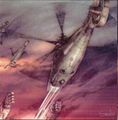Cavalry
Sarna News

- HEXTECH Review - Wave 3 Brings More Urban Options To Your Battlefield
- Your BattleTech News Round-Up For March, 2024
- Crashing 'Mechs With Jennifer Brozek, Author Of The Rogue Academy Trilogy
- Getting The Word Out With Rem Alternis, Catalyst Community & Marketing Director
- Bad 'Mechs - Yeoman
- Read more →

| |
| Cavalry Attack Helicopter | |
| Production information | |
| Manufacturer | Michaelson Heavy Industries [1] |
| Production Year | 3054[2] |
| Mission | Anti-vehicle hunter/killer |
| Type | VTOL |
| Technical specifications | |
| Mass | 25 tons |
| Armor | StarSlab/3 |
| Engine | Michaelson 110 Internal Combustion |
| Speed | 162 km/h |
| Crew | 2 |
| Communications System | Garret Supremesound |
| Targeting Tracking System | Garret D2j |
| Heat Sinks | None |
| Armament | |
| BV (1.0) | 632[3] |
| BV (2.0) | 503[4] |
Contents
Description[edit]
Introduced in 3054, the Cavalry Attack Helicopter was one of a number of VTOLs developed to fight the Clans by Michaelson Heavy Industries. Designed for hit-and-run engagements rather than front-line combat situations, due in part of its ammunition supply running low in prolonged battles, when used correctly the Cavalry attracted a reputation for flawless service with both halves of the sundered Armed Forces of the Federated Commonwealth prior to and during the FedCom Civil War. The Cavalry soon saw service in both former FedCom States and minor-nobles among the Chaos March,[5] and soon grew popular across the Inner Sphere. Sales were opened to all interested parties after a decade.[6]
While capable of speeds up to 162 km/h, the Cavalry doesn't rely on this alone for protection and has been noted for carrying 3.5 tons standard Star Slab/3 armor. While the rotor is no less fragile than other VTOL designs, the craft can handle a direct hit from a Clan-tech ER PPC on the nose and keep flying.[5]
Weapons and Equipment[edit]
The aircraft's main armaments consist of an array of short-range missile launchers. A six-tube launcher is mounted in the front, with three additional two-tube launchers co-axed to it. The six-tube launcher has been given only 15 rounds of ammunition, while the smaller two-tube launchers have 50 missiles in a shared ammo bay.[5]
Variants[edit]
- Infantry
- In this variant, introduced in 3063, the 110-rated ICE engine is replaced with a fusion engine. This allows for a four-ton infantry bay, three forward-mounted medium lasers, and three machine guns with a half-ton of ammunition.[9] BV (1.0) = 744[10], BV (2.0) = 615[11]
- CADENCE RAIN
- The CADENCE RAIN Cavalry copter was designed during the Jihad by a team led by Jean Paul Quenano to deliver the new CORAL INTENT Infiltrator Battle Armor to the battlefield. Designers started by removing the existing armor and replacing it with vehicular stealth armor and a Guardian ECM suite. A four-ton infantry bay carries a squad of battle armor. To improve survivability, a VTOL jet booster was added to allow the CADENCE RAIN copters to temporarily double their cruising speed. The existing weapons were removed and replaced with three Magshots. Though insufficient to destroy 'Mechs and heavy vehicles, they're able to drive off enemy Battle Armor and infantry forces. BV (2.0) = 568[14]
- Cavalry Infiltrator
- Similar to the CADENCE RAIN version, this variant produced by Cal-Boeing of Dorwinion carries a pair of Magshots in a VTOL chin turret. It retains the stealth armor, Guardian ECM, and VTOL jet booster of CADENCE RAIN, along with the four-ton infantry bay. BV (2.0) = 446[15]
Design Quirks[edit]
The Cavalry Infiltrator variant is subject of the following Design Quirks:[15]
Notable Pilots[edit]
Notes[edit]
- A third variant of the Cavalry is mentioned, written as a redesign of the aircraft with a two-man piloting/gunner crew.
Gallery[edit]
Original Cavalry Attack VTOL from Chaos March
Cavalry Attack VTOL from TRO:3058
Cavalry "Infiltrator" from TRO:Prototypes
Cavalry from MechWarrior: Dark Age
Cavalry in combat from CCG
References[edit]
- ↑ Technical Readout 3058 Upgrade p.62
- ↑ MUL online date for the Cavalry
- ↑ Record Sheets: 3058 Upgrades, p. 75
- ↑ Record Sheets: 3058 Unabridged (Inner Sphere), p. 20
- ↑ 5.0 5.1 5.2 Technical Readout: 3058 Upgrade, pp. 62-63, "Cavalry VTOL Profile"
- ↑ MechWarrior: Dark Age - Dossiers and Pilot Cards, p. 189: "Dan Schiavello"
- ↑ Record Sheets: 3058 Upgrades, p. 76
- ↑ Record Sheets: 3058 Unabridged (Inner Sphere), p. 23
- ↑ Record Sheets: 3058 Upgrades, p. 80, "Cavalry (Infantry Variant)"
- ↑ Record Sheets: 3058 Upgrades, p. 76
- ↑ Record Sheets: 3058 Unabridged (Inner Sphere), p. 21
- ↑ Record Sheets: 3058 Unabridged (Inner Sphere), p. 22
- ↑ Record Sheets: 3058 Unabridged (Inner Sphere), p. 24
- ↑ Experimental Technical Readout: Davion, p. 8
- ↑ 15.0 15.1 Technical Readout: Prototypes, p. 31
Bibliography[edit]
- Experimental Technical Readout: Davion
- Master Unit List: Battle Values
- MechWarrior: Dark Age - Dossiers and Pilot Cards
- Record Sheets: 3055 & 3058
- Record Sheets: 3058 Unabridged (Inner Sphere)
- Record Sheets: 3058 Upgrades
- Technical Readout: 3058
- Technical Readout: 3058 Upgrade
- Technical Readout: Prototypes






